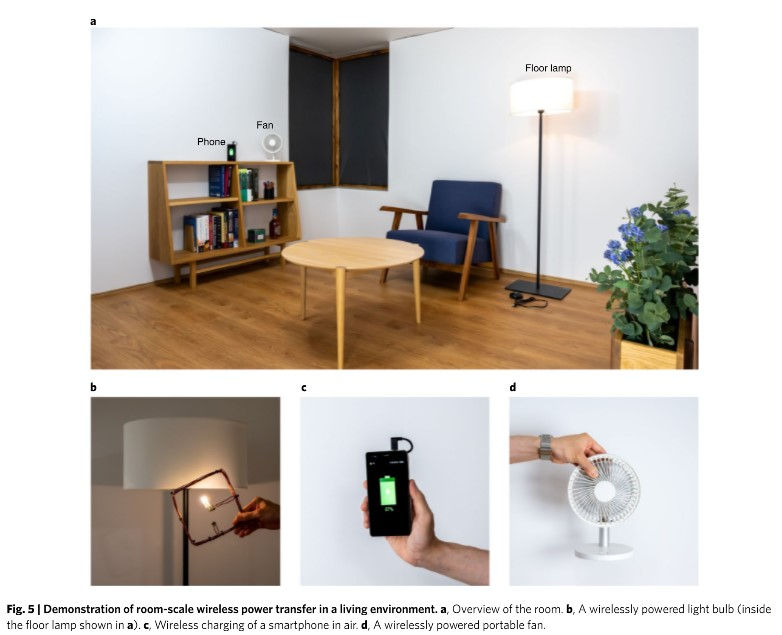Where We’re Going, We Don’t Need Wires
- Eureka WSRC
- Sep 22, 2021
- 4 min read
Updated: Sep 23, 2021
We’ve all been in that dreaded situation; you wake up in the morning and realize your phone wasn’t charging the whole night. How convenient would it be to have your device charge as you enter your room instead? With recent breakthroughs on wireless power transfer, this is gradually becoming a promising alternative. Conventional wireless charging associated with smartphones, smartwatches and earphones are often praised for their convenience. However, these are still tethered with cables, requiring the correct device orientation, and placing them on specific surfaces.

A new system developed by the University of Tokyo’s Graduate School of Engineering enables the transmission of energy to electronic devices within a room. The powered electronics are not limited to smartphones, but also small household appliances such as fans and lights without using electrical sockets or plugs.
The system is built upon the same fundamental workings of wireless phone chargers, consisting of a metal coil in presence of an alternating magnetic field that produces an electric current (also known as electromagnetic induction). First, a sine wave of 1.34 MHz is projected by a power source which is the resonant frequency of the room, this results in an electric current oscillating within the specialized aluminium walls, generating a 3D magnetic field. Receiver coils are augmented in devices, enabling them to be powered wirelessly. The technical term for this system is coined as magnetoquasistatic wireless power transfer. This opens opportunities for manufacturers to provide a new generation of sleeker and lightweight devices that demands less real estate for large batteries. In more extreme cases, it could even eliminate the need for batteries which then
removes the harmful environmental impacts of millions of disposed batteries in landfills (resulting in toxic heavy metals leeching in our soil and water).
Returning to the wireless charging room, efficiencies and the capabilities of the power transfer were tested by the researchers as well. Findings in testing presented efficiencies of a minimum 50% with highs reaching 90% in at least 98% of the room’s volume. These were dependent on the magnetic field strength affecting the receiver coil along with the coil’s orientation. Additionally, it was found that the output by the waves could reach potentials of 50 W or more.
The team constructed a custom made 3 x 3 x 2 m aluminium room with embedded capacitors within the panels. Consequently, this acts as a medium for the current to flow which then generates the 3D magnetic field within the room. Ordinary furniture such as a chair, table and a bookshelf were added in the room along with a lamp and a fan which were fitted with coil receivers and as tested, the furnished room did not interfere with the system. A concern for safety evidently arises when filling a metal room in an electric field. Posing an issue of heating biological tissue is quite alarming to us humans. Accordingly, Sasatani and his team installed capacitors to isolate potentially

Nature Electronics
harmful electric fields within the walls while also containing safe magnetic fields within the room. Subsequent tests were performed via simulation to gauge the safety of a human body present in the powered room and resulted in acceptable imits of electromagnetic radiation exposure established by the Federal Communications Commission. Nevertheless, co-author of the study Alanson Sample states that this is not a definitive conclusion for safety, “We’re not saying blanketly that this technology is safe under all uses—we’re still exploring.” 5 Sample, an associate professor at the University of Michigan’s electrical engineering and computer science department has been spearheading the idea of a wireless charger room since 2017. Improvements to the system since his time at Disney Research include eliminating the need of a copper pole to be installed in the centre of the room and the ability to charge regardless of device orientation by having multidirectional magnetic fields. 6 However, this was only a proof of concept and a showcase of a new technique as authors of the paper acknowledge the impracticality of installing aluminium panels in a room. Instead, theorising the possibilities of coating existing rooms with conductive material and constructing walls with built-in conductive layers. On the other hand, Takuya Sasatani, the project assistant professor and lead author reflects on how the power transmission could be optimised and ways to eliminate dead zones in the room. In a more optimistic light, there are various ways of applying this concept in industrial and specialised settings. For instance, in hospital operating rooms where medical instruments can be powered wirelessly and in manufacturing workshops, enabling wireless use of power equipment. These changes can potentially increase safety in the workplace as it removes the hazard of tripping on cables as well as providing the users with more physical freedom which can result in improved productivity. Soon, wireless charging can be synonymous with the term “distant-charging” instead, with companies venturing forth in technologies like beamforming, which directs the medium of transfer specifically to your device.

Systems like these are more compact, as the radio waves are sent via charging boxes rather than large aluminium walls, however, the magnetic fields used by Sasatani’s team are safer than radio waves. Additionally, electric cars get the opportunity of being wireless too, with companies like WiTricity developing charging pads for Nissan andToyota.
The realm of technology is everchanging and one day we could wake up to a world where charging is something we don’t have to think about anymore.
Lance
------------------------------------------------------------------------------------------------------------------------------------------------------------------------------------------------------------------------
Citations
1 https://newatlas.com/ikea-wireless-charging/36336/ itm_source=newatlas&itm_medium=article-body
2 https://www.scientificamerican.com/article/this-room-could-wirelessly-charge-all-your-devices/
3 Environmental Implications Of Lead-Acid And Lithium-Ion Batteries (forbes.com)
4 Room-scale magnetoquasistatic wireless power transfer using a cavity-based multimode resonator
5 https://www.scientificamerican.com/article/this-room-could-wirelessly-charge-all-your-devices/
6 https://newatlas.com/disney-research-qscr-wireless-
charging/47990/?itm_source=newatlas&itm_medium=article-body
7 Xiaomi's wireless tech promises to charge a smartphone across a room (newatlas.com)







Comments